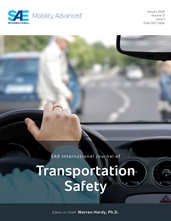This article entails the design, manufacturing, application, testing, and
analysis/discussion of a controller area network (CAN)–based vehicle safety
system that detects vehicle failure such as brake failure, gear failure, tire
blowouts, and other failures that can be monitored using digital or analogue
sensors. The aim and objectives are to implement a real-life tire blowout on an
Iveco S-Way Euro III and design a system that sends out CAN-based messages using
J1939 protocol to the Iveco S-Way Euro III to downshift the gears, retarders,
activate the limp mode braking system, activate the hooter, and activate the
hazards. The system is split into five sections: (1) detection and activation,
(2) gear control system, (3) retarder control system, (4) braking control
system, and (5) hooter and hazard control system; while analyzing the:
acceleration in the lateral, longitudinal, and vertical acceleration (g) vs.
time (s), vehicle speed (km/h), rate of deflation (s), and the steering torque
(Nm). The findings show that pressure (bar) vs. time (ms) indicates that the
rate of deflation without the countermeasures took 1.053 s longer, wheel speed
(mph) vs. time (s) indicates that the testing without countermeasures took
3.9800 s longer to reach 0 km/h, steering torque (Nm) vs. time (ms) indicates
that the testing without countermeasures had a maximum value that was 0.1179 Nm
higher than the testing with countermeasures, longitudinal acceleration (g) vs
time (s) indicates that the testing without countermeasures has more sporadic
values, lateral acceleration (g) vs time (s) indicated the testing with
countermeasures has a 0.132 g higher lateral acceleration, and vertical
acceleration (g) vs time (s) indicated that both tests (with and without
countermeasures) have almost the same maximum vertical acceleration when the
tire blowout occurred with the test without countermeasures having a 0.02 g
higher vertical acceleration than the testing with countermeasures.
